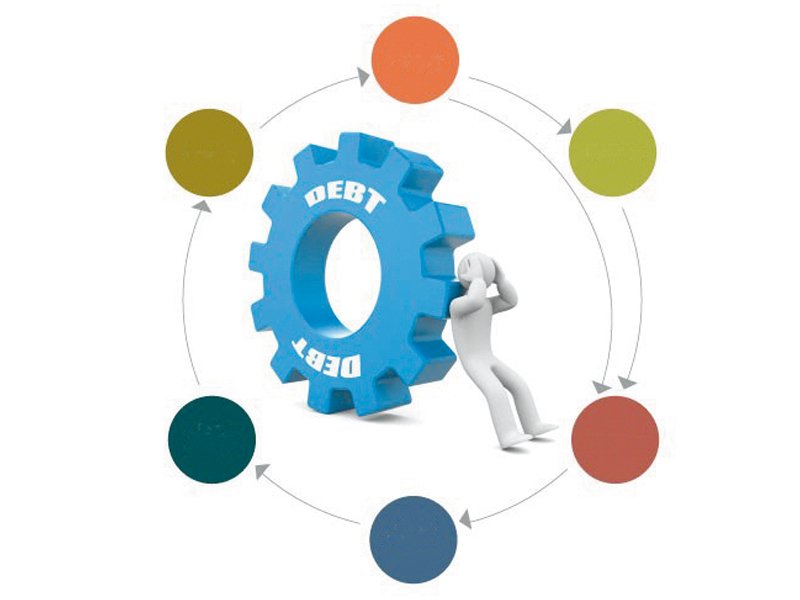
ISLAMABAD: The Pakistan Tehreek-e-Insaf (PTI) government has added about Rs565 billion to the circular debt - including Rs100 billion in the past six months alone - missing the International Monetary Fund’s (IMF) debt-accumulation reduction target for the second successive time.
After adjusting power subsidies, the average per month increase in the circular debt during the July-December period of fiscal year 2019-20 was Rs17 billion - higher than the government’s claim of Rs10 billion, according to sources in the Ministry of Finance and the Ministry of Energy.
Without subsidies, the gross per month increase in the circular debt was Rs29 billion. The government paid roughly Rs73 billion in power subsidies in first half of the current fiscal year, they added.
The government has been making efforts to improve efficiency but the power sector situation remains grim despite putting an additional burden of Rs405 billion on consumers in the past one year by increasing electricity prices.
Out of the Rs405 billion, the government recovered Rs195 billion in the first half of the fiscal year, according to the Ministry of Energy officials. The PTI is again set to increase electricity prices by around 30 paisa per unit - for the fifth time in over a year, according to the sources.
Debt continues to plague Pakistan's energy chain
When contacted, the Power Division spokesman did not deny that the government added Rs565 billion to the circular debt but defended the government’s performance. “It is a wrong way of putting the efforts made by the government for reducing the flow of circular debt. The first year saw a build-up because the actions required to reduce the build-up were set up and had little time to yield the desired results,” said Power Division spokesman Zafar Yab.
First half of the year saw a reduction in the build-up from Rs39 billion to about Rs15 billion per month, if calculated on average six-month basis, he added. “Had these efforts not been there, the build-up would have been more than Rs300 billion during the first half,” according to the spokesman.
However, the government could not bring major efficiency improvements. Its gains from reducing line losses and improving recoveries were only Rs25 billion as compared to the Rs195-billion benefit from increasing quarterly and annual tariffs four times, according to the sources.
Against the IMF’s relaxed target of adding Rs93 billion to the circular debt, the PTI government added slightly over Rs100 billion during the July-December period of current fiscal year, according to sources in the economic ministries.
At the time of signing the $6-billion bailout package, the IMF had allowed Pakistan to add only Rs39 billion to the circular debt during the July-December period. But it relaxed the limit to Rs93 billion in first review talks after the PTI government added Rs77 billion in the first quarter alone, bringing monthly addition to Rs25.7 billion.
In fiscal year 2018-19, the federal government added Rs465 billion to the circular debt, according to the IMF report. After the addition of over Rs100 billion in the past six months, the total addition to the circular debt was Rs565 billion - even after increasing electricity prices four times.
With the fresh addition, the total stock and flow of circular debt has jumped to over Rs1.72 trillion as of the end of December. This includes Rs812 billion parked in a government holding company. The remaining about Rs910 billion is the flow, including the Rs565 billon added by the PTI, which remains unsettled.
The IMF has already relaxed its annual circular debt accumulation reduction target from Rs81 billion to Rs134 billion for the current fiscal year. On the basis of results of the first half, it will be very difficult to even restrict the annual flow of circular debt to Rs134 billion by June.
'Investment in Pakistan increased by 78%'
But the Ministry of Energy officials believed that the impact of increasing the electricity prices in the past one year would be fully reflected in the remaining period of the current fiscal year, which would help to restrict the increase in the debt. Since January last year, the government increased the electricity prices by a cumulative Rs3.95 per unit and after the upcoming increase, the total tariff hike will jump to Rs4.25 a unit.
The government has recently prepared a plan to reduce the circular debt but the new plan, drawn up in consultation with the IMF, shows that there will be around Rs50-75 billion annual increase in the circular debt even by FY23, according to the IMF’s first review report.
Power Minister Omar Ayub had earlier claimed that the flow of circular debt would be reduced to zero by December 2020.
The Power Division spokesman said the circular debt build-up would first be reduced and then brought to zero. “Any residue that might be showing up will be handled through recoveries from the stock and tariff adjustments,” he added. The reason behind the constant bleeding is the bad financial and administrative shapes of four power distribution companies out of nine. These companies are feared to remain in bad shape for years and to keep adding to the circular debt on account of less recoveries and high line losses. The government has a plan to reduce their line losses by about 1% and improve recoveries by 1% this year.
Published in The Express Tribune, January 16th, 2020.
Like Business on Facebook, follow @TribuneBiz on Twitter to stay informed and join in the conversation.



















































COMMENTS
Comments are moderated and generally will be posted if they are on-topic and not abusive.
For more information, please see our Comments FAQ